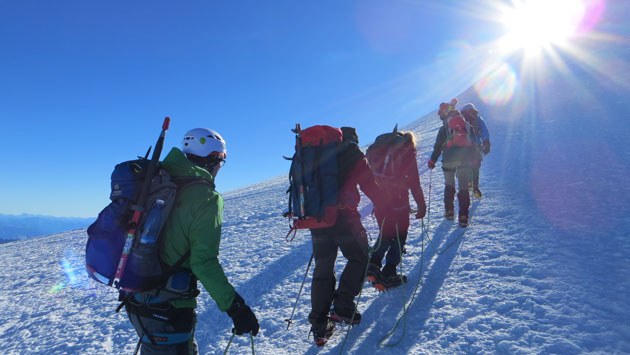When bad news is good news

Some of the test subjects are suffering. The diary of one female student participant records all that one would not want to have – massive headache, severe fatigue, nausea and vomiting, oedema – water retention – in the hands, insomnia. The first symptoms appeared during the climb, as the 10 test subjects first climbed from Alagna in Italy up to the Orestes Hut, and on to the Gnifetti Hut at an altitude of 3647 metres. On Tuesday it was finally time to climb to the final destination – the Regina Margherita Hut situated at an altitude of over 4500 metres.
For the participants with no – or only minor symptoms – of altitude sickness, it was a hike over the Lys Glacier with beautiful views; for the very sick, step by step, with crampons on their shoes and a five-kilogram pack on their backs, it was an arduous walk and anything but pleasurable. But, in this case, bad news is good news – DLR lead investigator Ulrich Limper needs to test subjects whose bodies are reacting to the lower air pressure and lack of oxygen.
Flying a freezer in for research
The Regina Margherita Hut sits atop a rocky crag in the Valais Alps. It is right on a precipice on the Italian side and just 30 metres from the Swiss border. At 4554 metres above sea level, it is the highest building in Europe. The Zugspitze, the highest mountain in Germany, is just 2962 metres high. The DLR team has turned a four-bed room in the hut into a laboratory; they sleep – or, depending on the level of altitude sickness, lie awake – in bunk beds in a ten-bed room. Six hundred kilograms of equipment were flown by helicopter to the top on Tuesday morning. Five hundred kilograms of the equipment include the freezer in which blood, urine and saliva samples are preserved until they can be analysed at the DLR site in Cologne and all the individual sample containers, in addition to blood sampling equipment and 50 kilograms of dry ice for keeping it all cold. Also included are 10 kilograms of personal luggage for each of the test subjects, who will have to do without a few amenities for the duration of the test – running water in the hut, separate rooms, privacy and, to an extent, physical comfort. The helicopter had to fly up to the hut twice before all of the equipment could be unloaded at over 4500 metres.

Slight to severe suffering
Only those test subjects who had not been to an altitude of over 3000 metres in the previous three months were considered for participation. They needed to be fit, with no heart or lung problems, and non-smokers – but experience at altitude was a deal-breaker. Limper is now seeing the full range of sickness – lucky people with very slight headaches, test subjects not doing too badly, and participants not feeling well at all, but whose bodies will hopefully adapt to the conditions quickly during the multiple-day stay at altitude.

"This is good for the study,” says the doctor. “Unfortunately, it is not so pleasant for some of the participants.” Thirty percent of the test subjects are doing relatively poorly – regardless of whether or not they are fit, their age and whether they are male or female. Nobody can predict who will get sick as long as altitude sickness is insufficiently investigated. Limper can dispense medication such as painkillers that alleviate the symptoms and stabilise the sickness, but stronger medication would falsify the data measurements – and the test subject would be much better off being taking down into the valley. The lead investigator can have the participants brought down from altitude by helicopter. However, this has not been necessary so far.
Altitude sickness in beautiful weather
Everyone is keeping a diary. How bad are they feeling? How strong are the headaches? Do they feel hungover and, if so, is it slightly, moderately or extremely? In addition, heart rate and oxygen saturation of the blood is measured during the multiple-day stay. In the valley, the latter is the normal 98 percent; at 3600 metres, it is just 85 to 90 percent. Now, in the Regina Margherita Hut, the participants are being supplied with a quarter less oxygen than in the valley. The first blood and saliva samples were taken on Tuesday afternoon. The ultrasound investigations began on Wednesday. These are used to determine if the body has stored liquid in the tissue.

It is clear that all participants who have made it through the first night in altitude without experiencing great discomfort are quite lucky enough to be rather insensitive to the symptoms of altitude sickness. Those who are well can continue to enjoy the clear skies and great views over the Valais Alps. Just minus eight degrees Celsius at night, but at least one degree Celsius during the day. For the other climbers that stop at the hut on their journey, the weather is ideal. And those unable to cope with the altitude can always ask the DLR doctor.
More images in the Flickr album.
Tags:
